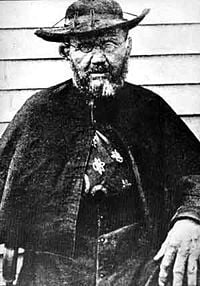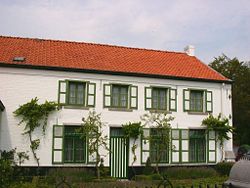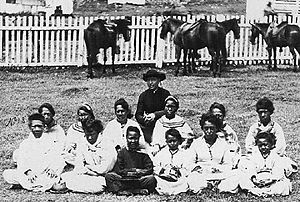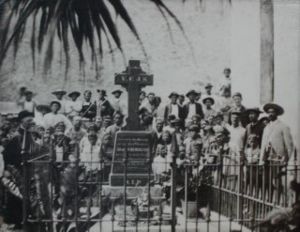Father Damien
| Blessed Damien of Molokai | |
|---|---|
Father Damien was a Roman Catholic missionary who helped lepers on the Hawaiian island of Molokaʻi, eventually succumbing to the disease himself. | |
| The Leper Priest | |
| Born | January, 3, 1840 in Tremelo, Belgium |
| Died | April 15, 1889 in Kalaupapa, Molokai, Hawaii |
| Venerated in | Roman Catholic Church, Anglican Church |
| Beatified | 1995, Rome |
| Major shrine | Leuven, Belgium (bodily relics); Maui, Hawaii (relics of his hand) |
| Feast | May 10 (universal); April 15 (in Hawaii) |
| Attributes | leprosy |
| Patronage | people with leprosy, outcasts, those with HIV/AIDS, the State of Hawaii. |
Father Damien, also known as Blessed Damien of Molokai (January 3, 1840 – April 15, 1889), was a Roman Catholic missionary priest from Belgium who is most noted for caring and ministering to people with leprosy. He spent much of his life working with lepers in Hawaii, who were forced by government-sanctioned medical segregation to live on the island of Molokai. In the Roman Catholic and Anglican traditions, as well as other denominations of Christianity, Damien is considered to be the spiritual patron for Hansen's Disease (leprosy), HIV and AIDS patients, as well as outcasts. As the patron saint of the Roman Catholic Diocese of Honolulu and of Hawaii, Father Damien Day is celebrated statewide on April 15. Upon his beatification by Pope John Paul II in 1995, Damien was given a memorial feast day, celebrated on May 10, on the church calendar. He was also then conferred the official title of Blessed Damien of Molokai.
Father Damien's tireless efforts to alleviate the suffering of leprosy, and, more importantly, to improve their self-dignity as human beings, earned him widespread respect throughout the world. Mahatma Gandhi acknowledged in his writings that Father Damien was an inspiration for his own efforts to alleviate the conditions of India's untouchables (dalits). His life of selfless service exemplified the ideals of compassion and sacrificial agape love that lie at the heart of many great religions.
In both ecumenical religious and non-sectarian communities, Damien is being adopted as the symbol of how society should treat HIV/AIDS patients, in defiance of misconceptions of the disease. This builds upon the priest's example of treating the Hawaiian lepers as human beings. To this end, several Damien Centers have been established worldwide to serve people diagnosed with HIV/AIDS.[1] In a similar manner, the Damien-Dutton Society has been set up in his honor for the explicit purpose of eliminating leprosy.
Birth
Damien was born Jozef ("Jef") de Veuster, the seventh[2] child of the corn merchant Frans de Veuster and his wife, Cato Wouters, in the village of Tremelo, in Flemish Brabant (Belgium). As a youth, he (and his siblings) were weaned on tales of the marvelous exploits of Christian saints and martyrs—an evidently formative experience, as four of the couple's eight children eventually went on to take up membership in holy orders.[3] Young Jef was a somewhat anomalous individual: On one hand, he was a stocky, thickset youth, easily able to perform physically demanding tasks when helping his father on the farm; on the other, he was also intensely calm and contemplative, receiving the nicknames "Silent Joseph" and "the Little Shepherd" from neighbors and family members.[4] Both of these propensities would serve him well in his future endeavors.
Following the example of his older siblings, he attended college at Braine-le-Comte, then entered the novitiate of the Congregation of the Sacred Hearts of Jesus and Mary in Leuven, taking the name of Damianus (Damiaan in Dutch) in his first vows (probably after Saint Damian).[5] He took this name in conscious imitation of Sts. Cosmas and Damian, ancient "physician-saints," who "went among the sick and were martyred for Christ."[6]
Several years later, the monastery received a moving entreaty from the Hawaiian episcopate, urging the order to send a delegation of monks to aid in their charitable and missionary activities. His brother was originally selected for this role and arrangements were made, but, at the last moment, he was struck by a crippling bout of typhoid fever (which made travel impossible). Given the unfortunate circumstances, Damien offered to travel in his brother's stead, a proposal that was eventually acceded to his ecclesiastical superiors.[7]
Mission to Hawaii
On March 19, 1864, Damien landed at Honolulu Harbor as a missionary. There, Damien was ordained to the priesthood on May 24, 1864, at the Cathedral of Our Lady of Peace, a church established by his religious order. Though somewhat under qualified (as he had only four years of religious instruction), Father Damien was immediately thrust into a public role—missionizing to the natives of the island, delivering sermons in (still rudimentary) Hawaiian, and performing other ecclesiastical duties. Though his superiors sometimes questioned his impetuosity, the young priest was undeniably zealous in the performance of his duties, which he undertook for several parishes spread throughout the archipelago.[8] After years of tireless work, he remarked in July of 1872 that "now I have enough chapels, rectories, animals, and fields. I'm going to be able to apply myself to taking care of the sick and studying this year. At least, if Providence doesn't send me elsewhere."[9] As Jourdain notes, this was an uncannily prescient statement, as it was within the year that Damien's true calling was revealed to him.
While Damien's missionary involvement brought him in contact with many of the Hawaiian people, he remained relatively unaware of the health crisis that was currently threatening the kingdom.
Health crisis
Native Hawaiians became afflicted by diseases inadvertently introduced to the Hawaiian Islands by foreign traders and sailors. Thousands died of influenza, syphilis, and other ailments which had never before affected Hawaiians. This included the plight of leprosy (today called Hansen's disease). Fearful of its spread, King Kamehameha V segregated the lepers of the kingdom and moved them to a settlement colony on the north side of the island of Molokai. The Royal Board of Health provided them with supplies and food but did not yet have the resources to offer proper health care.[10]
In all good faith the government and the Board of Health believed they had solved the problem in every respect by shipping the patients off to Molokai with daily rations, a pair of pants or a cotton dress, a two-room building that was supposed to be a hospital under the direction of an administrator and some assistants. Actually, however, it was a barbarous method of isolation and a frank admission that the disease was considered incurable…. Molokai quickly got the reputation of being a graveyard, a place of anarchy, a Sodom calling down a rain of fire and brimstone. There was no doctor, no nurse, no priest, no justice of the peace, no resident police, no work, no comfort—and no hope.[11]
Colony of death
In 1873, confronted with the need to minister to the assembled lepers on Molokai, Msgr. Louis Maigret, the vicar apostolic, was in a difficult position. While acknowledging the spiritual needs of the afflicted, he realized that this assignment could potentially be a death sentence. As a compromise, he suggested that the various priests under his authority could alternate, each spending two weeks ministering to the ailing of the leprosarium. Damien volunteered to be the first.[12]
Following his arrival at Kalaupapa, Molokai on May 10, 1873, Damien wrote to his superior
…to say that there was urgent work to do. Having landed with nothing, he needed "a case of wine, books for pious reading and study, some shirts, trousers, shoes, a bell, some rosaries, some catechisms, altar bread big and small, a sack of flour, a lockable chest with a key." Not knowing when or whether he was to be replaced, he asked who would be "the priest privileged to gather the harvest of the Lord," and he put himself forward: "You know my disposition. I want to sacrifice myself for the poor lepers."[13]
Given the willingness of his subordinate (plus the undesirability of the posting), Msgr. Louis Maigret agreed to Damien's request and formally assigned him to the leper community on Molokai. (Though this posting earned the accolades of virtually all native Hawaiians, the Health Board, some of whom were Protestant missionaries, took affront at the fact that they had not been consulted when this posting was created. In retaliation, they publicly declared that Damien was to be treated as a leper and kept secluded on Molokai, hoping that this would lead the priest to flee. Surprisingly enough, it had the opposite effect. The young priest accepted the conditions of his banishment and remained on Molokai to the end of his days.)[14]
Father Damien's time at the leper colony was evenly divided between religious and secular duties. More specifically, while he traveled throughout the wilds of the island in search of potential converts, administered sacraments to the bedridden and preached to the assembled invalids on Sundays,[15] he also realized that, as a priest, his efforts to simply succor these needy individuals sometimes had to take priority. In this, his brawny frame and history as a farm laborer were tremendously helpful, as he spent much of his time helping the islanders build themselves homes and churches, as well as constructing coffins and digging graves for the departed. (He also took it upon himself to bear water to the homes of the bed-ridden, even after plumbing had been installed on the island.)[16] Further, after receiving instruction from William Williamson (a settler who had become afflicted with the disease), the vigorous young priest was given instruction in bandaging wounds, draining sores, and applying ointments, acting as "doctor as well as priest."[17]
In his ministrations to the lepers, Damien attempted to treat them as brothers and sisters in faith, even when it meant having to mask or otherwise deny his understandable revulsion at the depredations of the disease. As Farrow describes, this attitude began from his first day on the island, when he accepted a gift of fruit from a local sufferer "without showing any emotion other than gratefulness, for from the beginning he was resolved to show the lepers that he experienced no fear or repulsion of them and their affliction."[18] This became part of his general approach to dealing with the lepers, and, throughout his tenure on the island, he made "no pains to avoid contact with an infected person, he deliberately ate from the same dishes when sharing their humble meals, and often his pipe was lent to a leper."[19] This policy of tolerance and inclusion also extended into his ministerial work, as he "chose to address his congregation not as 'my brothers,' but as 'we lepers.'"[20] Furthering this general humanizing impulse, Damien also used other tactics to improve the quality of life for his constituents. He organized regular horse races (as this was an exciting, competitive activity that even the relatively ill could still take part in), taught songs from the Catholic hymnody (with those singing accompanied by individuals playing instruments, many of which were either constructed by Damien himself or donated by well-wishers), and encouraged them to plant gardens and sell the produce (as a means of earning much-needed income).[21]
Though he was not alone on the island, being aided (on occasion) by a procession of assistants, deacons, and fellow missionaries, it is not an overstatement to give the zealous Belgian priest the bulk of the credit for his humanization of what had been a Dante-esque realm of pain and torment.
Order of Kalakaua
In honor of his work among the lepers, King David Kalakaua bestowed on Damien the honor Knight Commander of the Royal Order of Kalakaua. When Princess Lydia Liliuokalani visited the settlement to present the medal, she was reported as having been too distraught and heartbroken to read her speech.[22] The princess shared her experience with the world and publicly acclaimed Damien's efforts. Consequently, the priest's reputation spread across the United States and Europe, leading American Protestants and the Church of England to raise large sums of money for the mission and to send food, medicine, clothing, and supplies.[23]
Illness and death
In December 1884, as indicated in his diaries, Damien went about his evening ritual of soaking his feet in boiling water. When he removed them, he saw to his dismay that they were covered in blisters, despite the fact that he had not felt the heat. Reeling from this discovery, he consulted a renowned specialist, Dr. Arning, who confirmed that he had contracted leprosy.[24] Despite this distressing development, Damien continued to work vigorously to build as many homes as he could, though he also made plans for the continuation of programs he created after he was gone.
In response to this situation, four strangers came to Molokai to help the ailing missionary: Louis Lambert Conrardy, a Belgian priest; Mother Marianne Cope, Superior of the Franciscan Sisters of Syracuse; Joseph Dutton, an American Civil War soldier and member of the Third Order of Saint Francis; and, James Sinnett, a nurse from Chicago.[25] Each of these individuals aided the ailing priest to the best of their abilities: Conrardy took up pastoral duties, Cope organized a working hospital, Dutton attended to the construction and maintenance of the community's buildings, and Sinnett nursed Damien through the last phases of the disease.
Father Damien died on April 15, 1889, "like a child going to sleep."[26] He was 49 years old. After two days of public mourning, he was buried in the graveyard behind the small chapel that he had helped to build in his first year on the island.[27]
Criticisms
Upon his death, a global discussion arose as to the mysteries of Damien's life and his work on the island of Molokai. Much criticism came from the American Congregational and Presbyterian churches, who feared the influence of Catholicism (especially if Hawaii became a part of the United States).[28] They derided Damien as a "false shepherd" who was driven by personal ambition and ego. The most famous treatise published against Damien was by a Honolulu Presbyterian, Reverend C.M. Hyde, in a letter dated August 2, 1889, to a fellow pastor, Reverend H. B. Gage. Reverend Hyde wrote:
In answer to your inquiries about Father Damien, I can only reply that we who knew the man are surprised at the extravagant newspaper laudations, as if he was a most saintly philanthropist. The simple truth is, he was a coarse, dirty man, head-strong and bigoted. He was not sent to Molokai, but went there without orders; did not stay at the leper settlement (before he became one himself), but circulated freely over the whole island (less than half the island is devoted to the lepers), and he came often to Honolulu. He had no hand in the reforms and improvements inaugurated, which were the work of our Board of Health, as occasion required and means were provided. He was not a pure man in his relations with women, and the leprosy of which he died should be attributed to his vices and carelessness. Others have done much for the lepers, our own ministers, the government physicians, and so forth, but never with the Catholic idea of meriting eternal life.[29]
Having read the letter, Scottish author Robert Louis Stevenson, also a Presbyterian, drafted an acidic rebuttal, defending Damien and deriding Reverend Hyde for creating gossip to support his blatant anti-Catholic agenda. On October 26, 1889, Stevenson wrote:
When we have failed, and another has succeeded; when we have stood by, and another has stepped in; when we sit and grow bulky in our charming mansions, and a plain, uncouth peasant steps into the battle, under the eyes of God, and succours the afflicted, and consoles the dying, and is himself afflicted in his turn, and dies upon the field of honour—the battle cannot be retrieved as your unhappy irritation has suggested. It is a lost battle, and lost for ever.[29]
In addition to calling Reverend Hyde a "crank," Stevenson answered the charge that Damien was "not sent to Molokai but went there without orders" by arguing that:
Is this a misreading? Or do you really mean the words for blame? I have heard Christ, in the pulpits of our Church, held up for imitation on the ground that His sacrifice was voluntary. Does Dr. Hyde think otherwise?[29]
In the process of examining Damien's fitness for beatification and canonization, the Roman Curia pored over a great deal of documentation of published and unpublished criticisms against the missionary's life and work. Diaries and interviews were scoured and debated. In the end, it was found that what Stevenson called "heroism" was indeed genuine.[30]
Mahatma Gandhi
Mahatma Gandhi offered his own defense of Damien's life and work. Gandhi claimed Damien to have been an inspiration for his social campaigns in India that led to the freedom of his people and secured aid for those that needed it. Gandhi was quoted in M.S. Mehendale’s 1971 account, Gandhi Looks at Leprosy, as saying, "The political and journalistic world can boast of very few heroes who compare with Father Damien of Moloka'i. It is worthwhile to look for the sources of such heroism."[31]
Posthumous honors
In 1936, the Belgian government asked for the return of his body, in order to publicly commemorate his life and works:
[Upon arrival in Belgium,] the casket was placed before the platform on which stood Cardinal Van Roey, Primate of Beligium, members of the episcopate, and the King with his cabinet. A thrill passed through the crowd as they saw His Majesty King Leopold III step from his place and salute the son of a Tremeloo peasant…. Then, a hearse, drawn by six white horses, carried his body to the Cathedral where a solemn pontifical Mass was celebrated with magnificent ceremonies in the presence of the highest civil and religious personages of the land…. The remains of the humble missionary were again laid to rest in a crypt of St. Joseph's Chapel, a national shrine dedicated to Father Damien's patron, and directed by the Fathers of the Sacred Hearts.[32]
In addition to this commemoration, many secular associations have also chosen to honor the Beligian priest. For instance, a bronze statue of Father Damien honors the priest at the United States Capitol, with a full-size replica in front of the Hawaii State Legislature. Further, in 2005, Damien was given the title of De Grootste Belg (The Greatest Belgian) after a national poll conducted by the Flemish public broadcasting service, Vlaamse Radio- en Televisieomroep (VRT).[33]
Canonization process
On June 4, 1995, Pope John Paul II beatified Blessed Damien and gave him his official spiritual title. On December 20, 1999, Jorge Medina Estévez, Prefect of the Congregation for Divine Worship and the Discipline of the Sacraments, confirmed the November 1999 decision of the United States Conference of Catholic Bishops to place Blessed Damien on the liturgical calendar (feast day celebrated on May 10) with the rank of optional memorial. The Roman Catholic Diocese of Honolulu is currently awaiting findings by the Vatican as to the authenticity of several miracles attributed to Damien. Upon confirmation that those miracles are genuine, Blessed Damien could then be canonized and receive the title of Saint Damien of Molokaʻi.[34]
In Blessed Damien's role as patron of those with HIV and AIDS, the world's only Roman Catholic memorial chapel to those who have died of this disease, at the Église Saint-Pierre-Apôtre in Montreal, is consecrated to him.
Biographical films
After the beatification of Blessed Damien, Belgian film producer Tharsi Vanhuysse was inspired to lead a project honoring the famous priest. Vanhuysse teamed with film producer Grietje Lammertyn of ERA Films and searched for screenwriter, director, and lesser known actors. Australian David Wenham was chosen to play the lead, Paul Cox was selected to direct the project, and John Briley, who won an Academy Award for writing the screenplay to Richard Attenborough's Gandhi, provided the screenplay. The film, entitled Molokai: The Story of Father Damien, was released on March 17, 2000.
Previously, Father Damien life was also represented in the 1980 made-for-television film, Father Damien: Leper Priest.
Notes
- ↑ Damien Center, History. Retrieved August 15, 2008.
- ↑ Jourdain, 6-7.
- ↑ Ibid.
- ↑ Branson, 38-39.
- ↑ Damian, Biography. Retrieved August 15, 2008.
- ↑ Daws, 58.
- ↑ Daws, 30-31.
- ↑ Jourdain, 42-53.
- ↑ Jourdain, 75.
- ↑ Bunson, 72-79.
- ↑ Jourdain, 87.
- ↑ Daws, 55-56.
- ↑ Daws, 62-63.
- ↑ Jourdain, 107-112.
- ↑ Jourdain, 139-145.
- ↑ Bunson, 93-95.
- ↑ Daws, 84.
- ↑ Farrow, 129.
- ↑ Ibid, 138.
- ↑ Daws, 60.
- ↑ Bunson, 94-96.
- ↑ Farrow, 187-189.
- ↑ Jourdain, 221-227.
- ↑ Jourdain, 250-251.
- ↑ Bunson, 144-151.
- ↑ Jourdain, 375.
- ↑ Daws, 212-213.
- ↑ Daws, 224-226.
- ↑ 29.0 29.1 29.2 Robert Louis Stevenson, Father Damien. An Open Letter to the Reverend Dr. Hyde of Honolulu. Retrieved August 15, 2008.
- ↑ Bunson, 216-218.
- ↑ George Fox, Damien. Retrieved August 15, 2008.
- ↑ Jourdain, 383.
- ↑ VRT, De Grootste Belg (The Greatest Belgian) official article. Retrieved August 15, 2008.
- ↑ Bunson, 221-234.
References
ISBN links support NWE through referral fees
- Bunson, Margaret R. Father Damien: The Man and His Era. Huntington, IN: Our Sunday Visitor Books, 1997. ISBN 0-87973-916-9.
- Daws, Gavan. Holy Man: Father Damien of Molokai. Honolulu: University of Hawaii Press, 1994. ISBN 0-0248-0920-1.
- Eynikel, Hilde. Molokai: The Story of Father Damien. Alba House, 1999. ISBN 0340714190.
- Farrow, John. Damien the Leper. London: Burns Oates & Washbourne, 1937. ISBN 0385489119.
- Jourdain, Vital. The Heart of Father Damien. Translated from the French by Francis Larkin and Charles Davenport. Milwaukee: The Bruce Publishing Company, 1955.
- Stevenson, Robert Louis. Father Damien: An Open Letter to the Revered Dr. Hyde of Honolulu from Robert Louis Stevenson. Notre Dame, IN: Ave Maria Press, 1911.
- Stewart, Richard. Leper Priest of Moloka'i: The Father Damien Story. Honolulu: University of Hawai'i Press, 2001. ISBN 0824823222.
External links
All links retrieved March 25, 2024.
- Architect of the Capitol Biography of Blessed Damien
- Molokai: The Story of Father Damien—IMDB.com's article about the movie.
- Father Damien (Joseph de Veuster)—Catholic Encyclopedia article.
Credits
New World Encyclopedia writers and editors rewrote and completed the Wikipedia article in accordance with New World Encyclopedia standards. This article abides by terms of the Creative Commons CC-by-sa 3.0 License (CC-by-sa), which may be used and disseminated with proper attribution. Credit is due under the terms of this license that can reference both the New World Encyclopedia contributors and the selfless volunteer contributors of the Wikimedia Foundation. To cite this article click here for a list of acceptable citing formats.The history of earlier contributions by wikipedians is accessible to researchers here:
The history of this article since it was imported to New World Encyclopedia:
Note: Some restrictions may apply to use of individual images which are separately licensed.



